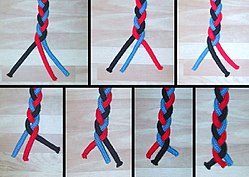Braid
This article needs additional citations for verification. (March 2015) |

A braid (also referred to as a plait; /plæt/) is a complex structure or pattern formed by interlacing three or more strands of flexible material such as textile yarns, wire, or hair.[1] The simplest and most common version is a flat, solid, three-stranded structure. More complex patterns can be constructed from an arbitrary number of strands to create a wider range of structures (such as a fishtail braid, a five-stranded braid, rope braid, a
Historically, the materials used have depended on the indigenous plants and animals available in the local area. During the
Hair braiding
The oldest known reproduction of hair braiding may go back about 30,000 years: the
Although many cultures want to take sole credit for the braid, they cannot be traced to a single origin. Like how different versions of Cinderella are traceable to nearly every culture, braids, too, are polygenetic. One early example of hair braiding takes place in 1279-1213 BCE as recorded in the story of Isis: "when some of the queen's maidens came to the well, she greeted them kindly and began to braid their hair."[5]
During the
Braiding is traditionally a social art.[citation needed] Because of the time it takes to braid hair, people have often taken time to socialize while braiding and having their hair braided. It begins with the elders making simple knots and braids for younger children. Older children watch and learn from them, start practicing on younger children, and eventually learn the traditional designs. This carries on a tradition of bonding between elders and the new generation.
Industrial history and use
Early braids had many uses, such as costume decoration, animal
Materials that are used in braids can vary depending on local materials. For instance, South Americans used the very fine fibers from the wool of
For nomadic peoples, braiding was a practical means of producing useful and decorative textiles. In other areas, such as the
Braids are also very good for making rope and decorative objects.[9] Complex braids have been used to create hanging fibre artworks.
Gold braids and silver braids are components or trims of many kinds of
, on headgear).Ropes and cables

Braiding creates a composite rope that is thicker than the non-interlaced strands of
In electrical and electronic cables, braid is a tubular sheath made of braided strands of metal placed around a central cable for shielding against electromagnetic interference. The braid is grounded while the central conductor(s) carries the signal. The braid may be used in addition to a foil jacket to increase shielding and durability. Litz wire uses braids of thin insulated wires to carry high frequency signals with much lower losses from skin effect or to minimise proximity effect in transformers. Flat braids made of many copper wires can also be used for flexible electrical connections between large components. The numerous smaller wires comprising the braid are much more resistant to breaking under repeated motion and vibration than is a cable of larger wires.
Similar braiding is used on pressurized
A property of the basic braid is that removing one strand unlinks the other two, as they are not twisted around each other. Mathematically, a braid with that property is called a
Onion and garlic
Onion and garlic stalks are often braided for storage after they are partially dried.[10][11][12]
Metaphors

Braids are often used figuratively to represent interweaving or combination, such as in, "He braided many different ideas into a new whole."
In some river and stream systems, small streams join and redivide in many places. Such stream systems are said to be braided.[13] These are often found in alluvial fans at the outlet of canyons. This is a result of heavy sediment deposition at high flows followed by re-erosion at low flows.
Gallery
-
A gold braid on a police uniform
-
A close up of a red braided USB cable.
See also
- African hair threading
- Braiding machines
- Braid theory
- Ceinture fléchée
- Kumihimo, Japanese braid
- List of hairstyles
- Ply-split braiding
- Sennit
- Lucet
References
- ISBN 9780857091352.
- ISBN 9780081009260.
- ISBN 9780081009260.
- ^ "Nude woman (Venus of Willendorf)". khanacademy.org. Archived from the original on 13 November 2014. Retrieved 1 May 2018.
- OCLC 28359877.
- ^ "The history of hair, hair styles through the ages". Archived from the original on 2007-04-26. Retrieved 2007-04-29.
- ^ "BRAIDS HAIRSTYLES 2018". Archived from the original on 26 September 2018. Retrieved 26 September 2018.
- ISBN 0-87033-161-2
- ^ "Braid Hairstyles Guide - DIY". Iknowhair.com. 19 October 2010. Archived from the original on 2013-11-12. Retrieved 2013-11-22.
- ISBN 978-1-4930-3665-3.
- ^ Winger, Jill (2016-09-28). "How to Braid Garlic • The Prairie Homestead". The Prairie Homestead. Retrieved 2023-08-12.
- Washington Post.
- ISBN 9780857003379. Archivedfrom the original on 5 October 2016. Retrieved 1 March 2016.
External links
 Media related to Braids at Wikimedia Commons
Media related to Braids at Wikimedia Commons The dictionary definition of braid at Wiktionary
The dictionary definition of braid at Wiktionary- Minnesota Statute Sec.155A.28 https://www.revisor.mn.gov/statutes/cite/155A.28



